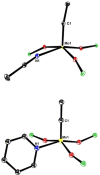Canopy Catalysts for Alkyne Metathesis: Investigations into a Bimolecular Decomposition Pathway and the Stability of the Podand Cap
- PMID: 34293239
- PMCID: PMC8518412
- DOI: 10.1002/chem.202102080
Canopy Catalysts for Alkyne Metathesis: Investigations into a Bimolecular Decomposition Pathway and the Stability of the Podand Cap
Abstract
Molybdenum alkylidyne complexes with a trisilanolate podand ligand framework ("canopy catalysts") are the arguably most selective catalysts for alkyne metathesis known to date. Among them, complex 1 a endowed with a fence of lateral methyl substituents on the silicon linkers is the most reactive, although fairly high loadings are required in certain applications. It is now shown that this catalyst decomposes readily via a bimolecular pathway that engages the Mo≡CR entities in a stoichiometric triple-bond metathesis event to furnish RC≡CR and the corresponding dinuclear complex, 8, with a Mo≡Mo core. In addition to the regular analytical techniques, 95 Mo NMR was used to confirm this unusual outcome. This rapid degradation mechanism is largely avoided by increasing the size of the peripheral substituents on silicon, without unduly compromising the activity of the resulting complexes. When chemically challenged, however, canopy catalysts can open the apparently somewhat strained tripodal ligand cages; this reorganization leads to the formation of cyclo-tetrameric arrays composed of four metal alkylidyne units linked together via one silanol arm of the ligand backbone. The analogous tungsten alkylidyne complex 6, endowed with a tripodal tris-alkoxide (rather than siloxide) ligand framework, is even more susceptible to such a controlled and reversible cyclo-oligomerization. The structures of the resulting giant macrocyclic ensembles were established by single-crystal X-ray diffraction.
Keywords: alkyne metathesis; metal alkylidynes; metal-metal bonding; molybdenum; tungsten.
© 2021 The Authors. Chemistry - A European Journal published by Wiley-VCH GmbH.
Conflict of interest statement
The authors declare no conflict of interest.
Figures













Similar articles
-
Organometallic Chemistry of Transition Metal Alkylidyne Complexes Centered at Metathesis Reactions.J Am Chem Soc. 2022 Jul 20;144(28):12546-12566. doi: 10.1021/jacs.2c01192. Epub 2022 Jul 6. J Am Chem Soc. 2022. PMID: 35793547 Review.
-
"Canopy Catalysts" for Alkyne Metathesis: Molybdenum Alkylidyne Complexes with a Tripodal Ligand Framework.J Am Chem Soc. 2020 Jun 24;142(25):11279-11294. doi: 10.1021/jacs.0c04742. Epub 2020 Jun 9. J Am Chem Soc. 2020. PMID: 32463684 Free PMC article.
-
Molybdenum Alkylidyne Complexes with Tripodal Silanolate Ligands: The Next Generation of Alkyne Metathesis Catalysts.Angew Chem Int Ed Engl. 2019 Oct 28;58(44):15690-15696. doi: 10.1002/anie.201908571. Epub 2019 Sep 17. Angew Chem Int Ed Engl. 2019. PMID: 31449713 Free PMC article.
-
Alkyne metathesis by molybdenum and tungsten alkylidyne complexes.Chem Commun (Camb). 2013 Jun 21;49(49):5529-31. doi: 10.1039/c3cc42609b. Chem Commun (Camb). 2013. PMID: 23673995
-
Well-Defined Alkyne Metathesis Catalysts: Developments and Recent Applications.Chemistry. 2019 Mar 1;25(13):3190-3208. doi: 10.1002/chem.201804511. Epub 2018 Dec 14. Chemistry. 2019. PMID: 30346054 Review.
Cited by
-
A Unified Approach to Polycyclic Alkaloids of the Ingenamine Estate: Total Syntheses of Keramaphidin B, Ingenamine, and Nominal Njaoamine I.J Am Chem Soc. 2021 Sep 8;143(35):14402-14414. doi: 10.1021/jacs.1c07955. Epub 2021 Aug 27. J Am Chem Soc. 2021. PMID: 34448391 Free PMC article.
-
From the Glovebox to the Benchtop: Air-Stable High Performance Molybdenum Alkylidyne Catalysts for Alkyne Metathesis.J Am Chem Soc. 2023 Dec 13;145(49):26993-27009. doi: 10.1021/jacs.3c10430. Epub 2023 Nov 30. J Am Chem Soc. 2023. PMID: 38032858 Free PMC article.
-
Total Synthesis of Njaoamine C by Concurrent Macrocycle Formation.J Am Chem Soc. 2023 Oct 4;145(39):21197-21202. doi: 10.1021/jacs.3c08410. Epub 2023 Sep 21. J Am Chem Soc. 2023. PMID: 37734001 Free PMC article.
-
The Ascent of Alkyne Metathesis to Strategy-Level Status.J Am Chem Soc. 2021 Sep 29;143(38):15538-15555. doi: 10.1021/jacs.1c08040. Epub 2021 Sep 14. J Am Chem Soc. 2021. PMID: 34519486 Free PMC article.
-
Total Synthesis of the Tetracyclic Pyridinium Alkaloid epi-Tetradehydrohalicyclamine B.Angew Chem Int Ed Engl. 2022 Oct 10;61(41):e202209651. doi: 10.1002/anie.202209651. Epub 2022 Sep 2. Angew Chem Int Ed Engl. 2022. PMID: 35971850 Free PMC article.
References
-
- Schrock R. R., Angew. Chem. Int. Ed. 2006, 45, 3748–3759; - PubMed
- Angew. Chem. 2006, 118, 3832–3844.
-
- Fürstner A., Davies P. W., Chem. Commun. 2005, 2307–2320. - PubMed
-
- Fürstner A., Angew. Chem. Int. Ed. 2013, 52, 2794–2819; - PubMed
- Angew. Chem. 2013, 125, 2860–2887.
-
- Fürstner A., Science 2013, 341, 1229713. - PubMed
-
- Ehrhorn H., Tamm M., Chem. Eur. J. 2019, 25, 3190–3208. - PubMed
MeSH terms
Substances
Grants and funding
LinkOut - more resources
Full Text Sources
Other Literature Sources
Miscellaneous

